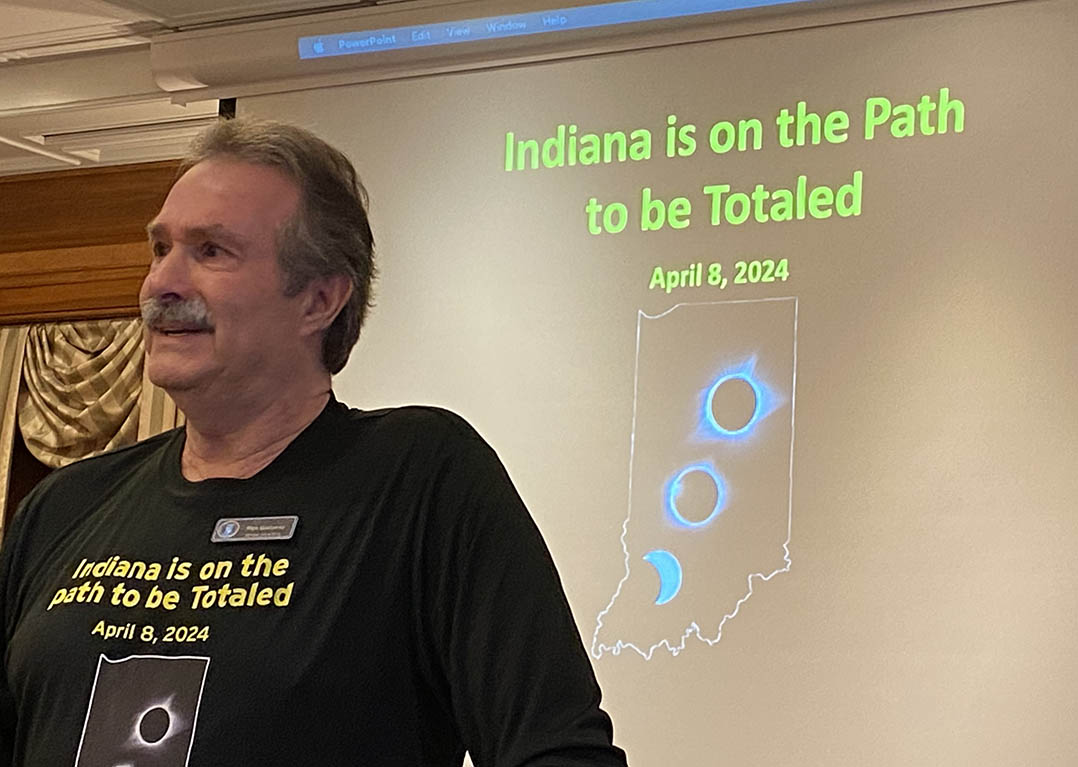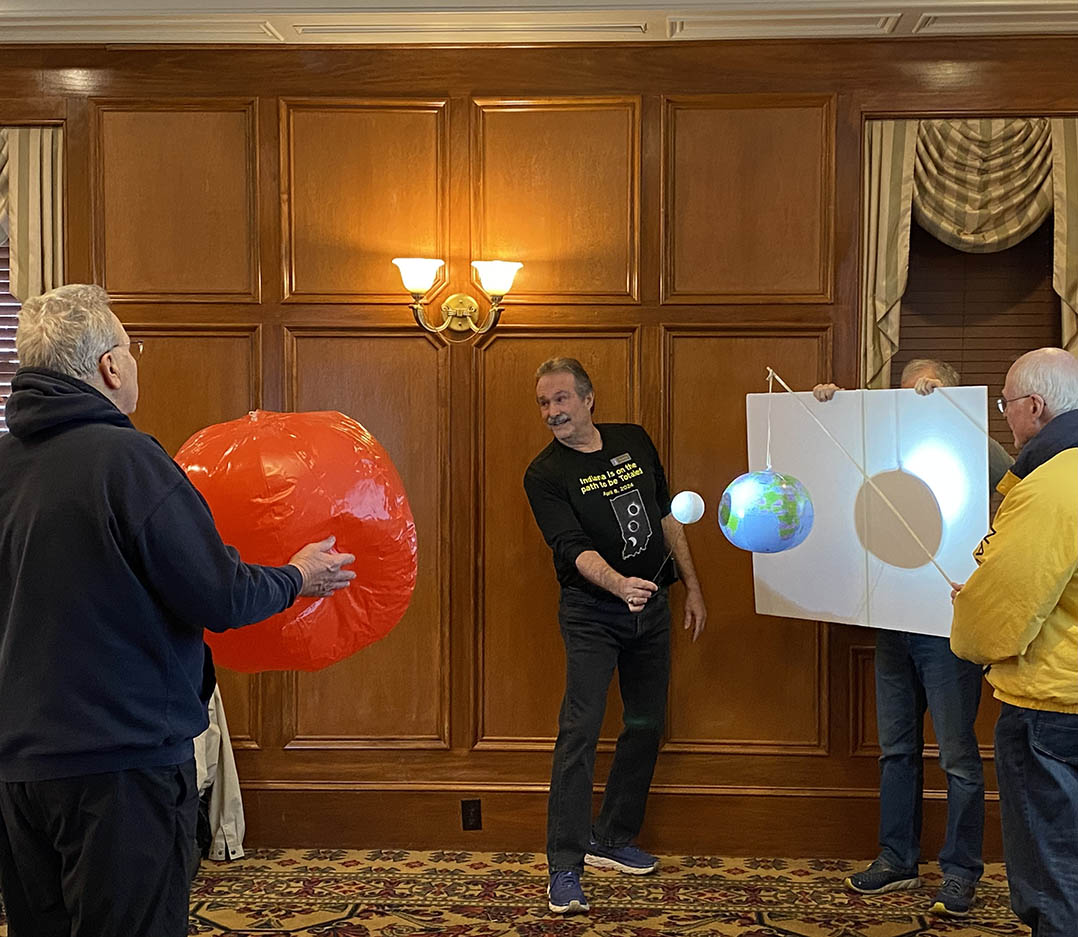Rick Galloway of the Indiana Astronomical Society wears his science-enthusiast colors with pride.
Sporting a T-shirt that stated, “Indiana is on the path to be totaled,” Galloway recently led a presentation at the Fort Harrison State Park Inn that focused on the upcoming April 8 total solar eclipse. Central Indiana is directly in the eclipse’s path of totality.
Galloway started with a funny story about his shirt.
“Last October, my wife and I were driving down to Florida for fall break and we stopped at a gas station in Tennessee,” he said. “I went inside to get a cola or something to drink. And the lady behind the counter was ringing it up. She looks at (my shirt) and she looks at me (and said), ‘Is there something bad that’s going to happen in Indiana?’”
Nope — it’s good, and very, very cool. A little after 3 p.m. April 8, people in central Indiana will experience a total eclipse, something that hasn’t happened in this area for more than 800 years.
But what is an eclipse, and how does it occur?
“In its simplest, simplest terms, … what it does is, the moon lines up directly (between) the sun (and Earth) and puts a shadow onto the Earth,” Galloway said. “Simplest thing, but astronomically, it’s a very difficult thing to be able to do.”
That’s because the moon has an elliptical and angled orbit, so the lining-up part doesn’t happen very often, at least not over any specific spot.
“On average, somewhere on Earth about every year and a half, 18 months, we’ll have a total eclipse,” Galloway said. “The problem is, many times they’re out over the ocean — no way to go see it. So, having this thing come through the middle of Indiana is extraordinarily rare. And this is just so cool. This is so amazing.”
The upcoming eclipse also coincides with a predicted uptick in solar activity, Galloway said, which means that when the eclipse reaches totality — a complete covering of the sun by the moon — the corona, or outer atmosphere of the sun, likely will be even more spectacular.
When the eclipse has reached totality — and only at that time — Galloway said it is safe to remove special eclipse-viewing glasses. It’s a brief window of time, though, because as soon as totality starts to wane, the glasses need to go back on. He recommends getting special viewing glasses sooner rather than later.
“Being able to get these things online is getting more and more difficult,” he said, stressing that the eclipse safety glasses must be ISO certified, and there is no substitute. “Sunglasses, no. Welders glasses, no. I had one kid at a high school presentation, he says, ‘Well, what happens if I put on 18 pairs of sunglasses?’ Still no. Certified is the way to go.”
Looking directly at the sun before or after totality can cause severe eye damage.
Galloway said that when using binoculars, telescopes or any kind of camera, an ISO-certified filter lens made from the same material as the glasses must be placed on the front exterior lens, even if you’re wearing safety glasses while looking through it. A filter not only protects the eyes, it protects digital cameras, including phone cameras, from expensive damage.
Photographing a solar eclipse can be challenging. Galloway, who is a photographer, said a digital camera with a zoom lens can work well — just remember to remove the filter once totality is reached and then put it back on when totality starts to wane.
For those with phone cameras, he recommends a filter, of course (you can take apart a spare pair of safety glasses and tape one of the filters over the lens), along with a small tripod to keep the phone steady and an app called Solar Snap. The app manufacturer sells a kit to help with cell-phone eclipse photography, but the app itself is free and provides simple guidance to inexperienced photographers about how best to get a shot of the eclipse.
Galloway said several times that the weather on April 8 will be perfect, with no clouds for miles. But, he admitted, there’s actually only about a 40 percent chance of clear skies that day.
“This is what keeps me up at night,” he said. “This is what wakes me up in the middle of the night and makes me have night sweats.”
Galloway said he has four weather apps on his phone, and he won’t decide until a few days before the eclipse where he’ll go for optimal viewing, based on what those apps predict. If it is overcast that day, he said people in central Indiana will still see something. It won’t be nearly as cool as it could be, though.
“Things will just get darker and darker and darker,” he said. “So, remember, it’s going to be hundreds of miles from the nearest cloud on that day, beautiful, bright, sunny, 62 degrees.”
Fingers crossed.
For more, visit iasindy.org or science.nasa.gov/eclipses/future-eclipses/eclipse-2024.

Total eclipses are going extinct
Nobody on Earth today will be around to witness it, but in about 600 million years, give or take a few years, there will no longer be total solar eclipses.
Rick Galloway of the Indiana Astronomical Society said that’s because the Earth and its moon, which is named Luna, are very, very slowly moving away from each other, which means the shadow the moon casts on the earth during an eclipse will be narrower and won’t completely cover the sun.
“It’s pretty neat that they can measure this thing at 4 centimeters a year,” he said. “They basically put mirrors up on the moon, and they sit here on the Earth, and they shine lasers back and forth, and they can tell with that much accuracy — 4 centimeters a year, 600 million years, it’s going to be so you’ll only have annular eclipses. You won’t have total eclipses anymore. But I don’t think we’ve got too much to worry about.”
During an annular eclipse, the edges of the sun remain visible, creating a bright ring around the moon.





